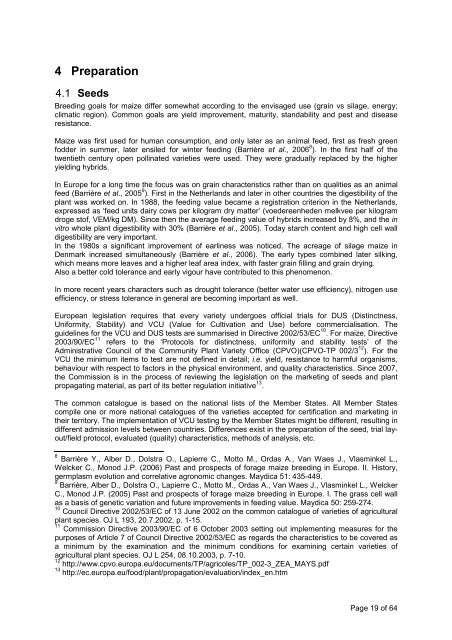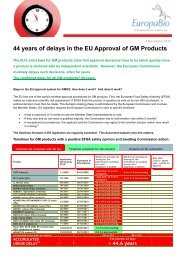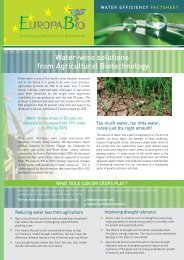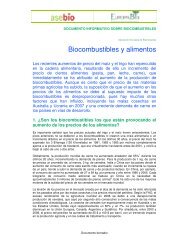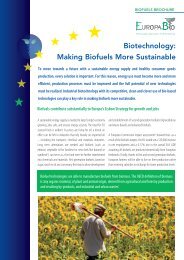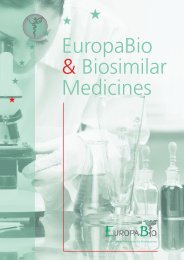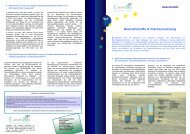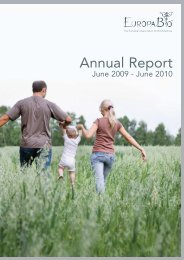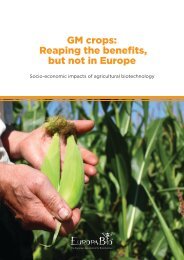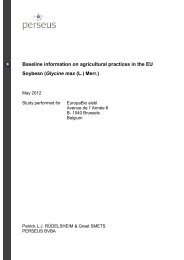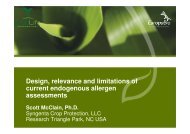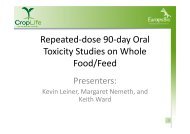Baseline information on agricultural practices in the EU ... - Europabio
Baseline information on agricultural practices in the EU ... - Europabio
Baseline information on agricultural practices in the EU ... - Europabio
Create successful ePaper yourself
Turn your PDF publications into a flip-book with our unique Google optimized e-Paper software.
4 Preparati<strong>on</strong><br />
4.1 Seeds<br />
Breed<strong>in</strong>g goals for maize differ somewhat accord<strong>in</strong>g to <strong>the</strong> envisaged use (gra<strong>in</strong> vs silage, energy;<br />
climatic regi<strong>on</strong>). Comm<strong>on</strong> goals are yield improvement, maturity, standability and pest and disease<br />
resistance.<br />
Maize was first used for human c<strong>on</strong>sumpti<strong>on</strong>, and <strong>on</strong>ly later as an animal feed, first as fresh green<br />
fodder <strong>in</strong> summer, later ensiled for w<strong>in</strong>ter feed<strong>in</strong>g (Barrière et al., 2006 8 ). In <strong>the</strong> first half of <strong>the</strong><br />
twentieth century open poll<strong>in</strong>ated varieties were used. They were gradually replaced by <strong>the</strong> higher<br />
yield<strong>in</strong>g hybrids.<br />
In Europe for a l<strong>on</strong>g time <strong>the</strong> focus was <strong>on</strong> gra<strong>in</strong> characteristics ra<strong>the</strong>r than <strong>on</strong> qualities as an animal<br />
feed (Barrière et al., 2005 9 ). First <strong>in</strong> <strong>the</strong> Ne<strong>the</strong>rlands and later <strong>in</strong> o<strong>the</strong>r countries <strong>the</strong> digestibility of <strong>the</strong><br />
plant was worked <strong>on</strong>. In 1988, <strong>the</strong> feed<strong>in</strong>g value became a registrati<strong>on</strong> criteri<strong>on</strong> <strong>in</strong> <strong>the</strong> Ne<strong>the</strong>rlands,<br />
expressed as ‘feed units dairy cows per kilogram dry matter’ (voedereenheden melkvee per kilogram<br />
droge stof, VEM/kg DM). S<strong>in</strong>ce <strong>the</strong>n <strong>the</strong> average feed<strong>in</strong>g value of hybrids <strong>in</strong>creased by 8%, and <strong>the</strong> <strong>in</strong><br />
vitro whole plant digestibility with 30% (Barrière et al., 2005). Today starch c<strong>on</strong>tent and high cell wall<br />
digestibility are very important.<br />
In <strong>the</strong> 1980s a significant improvement of earl<strong>in</strong>ess was noticed. The acreage of silage maize <strong>in</strong><br />
Denmark <strong>in</strong>creased simultaneously (Barrière et al., 2006). The early types comb<strong>in</strong>ed later silk<strong>in</strong>g,<br />
which means more leaves and a higher leaf area <strong>in</strong>dex, with faster gra<strong>in</strong> fill<strong>in</strong>g and gra<strong>in</strong> dry<strong>in</strong>g.<br />
Also a better cold tolerance and early vigour have c<strong>on</strong>tributed to this phenomen<strong>on</strong>.<br />
In more recent years characters such as drought tolerance (better water use efficiency), nitrogen use<br />
efficiency, or stress tolerance <strong>in</strong> general are becom<strong>in</strong>g important as well.<br />
European legislati<strong>on</strong> requires that every variety undergoes official trials for DUS (Dist<strong>in</strong>ctness,<br />
Uniformity, Stability) and VCU (Value for Cultivati<strong>on</strong> and Use) before commercialisati<strong>on</strong>. The<br />
guidel<strong>in</strong>es for <strong>the</strong> VCU and DUS tests are summarised <strong>in</strong> Directive 2002/53/EC 10 . For maize, Directive<br />
2003/90/EC 11 refers to <strong>the</strong> ‘Protocols for dist<strong>in</strong>ctness, uniformity and stability tests’ of <strong>the</strong><br />
Adm<strong>in</strong>istrative Council of <strong>the</strong> Community Plant Variety Office (CPVO)(CPVO-TP 002/3 12 ). For <strong>the</strong><br />
VCU <strong>the</strong> m<strong>in</strong>imum items to test are not def<strong>in</strong>ed <strong>in</strong> detail; i.e. yield, resistance to harmful organisms,<br />
behaviour with respect to factors <strong>in</strong> <strong>the</strong> physical envir<strong>on</strong>ment, and quality characteristics. S<strong>in</strong>ce 2007,<br />
<strong>the</strong> Commissi<strong>on</strong> is <strong>in</strong> <strong>the</strong> process of review<strong>in</strong>g <strong>the</strong> legislati<strong>on</strong> <strong>on</strong> <strong>the</strong> market<strong>in</strong>g of seeds and plant<br />
propagat<strong>in</strong>g material, as part of its better regulati<strong>on</strong> <strong>in</strong>itiative 13 .<br />
The comm<strong>on</strong> catalogue is based <strong>on</strong> <strong>the</strong> nati<strong>on</strong>al lists of <strong>the</strong> Member States. All Member States<br />
compile <strong>on</strong>e or more nati<strong>on</strong>al catalogues of <strong>the</strong> varieties accepted for certificati<strong>on</strong> and market<strong>in</strong>g <strong>in</strong><br />
<strong>the</strong>ir territory. The implementati<strong>on</strong> of VCU test<strong>in</strong>g by <strong>the</strong> Member States might be different, result<strong>in</strong>g <strong>in</strong><br />
different admissi<strong>on</strong> levels between countries. Differences exist <strong>in</strong> <strong>the</strong> preparati<strong>on</strong> of <strong>the</strong> seed, trial layout/field<br />
protocol, evaluated (quality) characteristics, methods of analysis, etc.<br />
8<br />
Barrière Y., Alber D., Dolstra O., Lapierre C., Motto M., Ordas A., Van Waes J., Vlasm<strong>in</strong>kel L.,<br />
Welcker C., M<strong>on</strong>od J.P. (2006) Past and prospects of forage maize breed<strong>in</strong>g <strong>in</strong> Europe. II. History,<br />
germplasm evoluti<strong>on</strong> and correlative agr<strong>on</strong>omic changes. Maydica 51: 435-449.<br />
9<br />
Barrière, Alber D., Dolstra O., Lapierre C., Motto M., Ordas A., Van Waes J., Vlasm<strong>in</strong>kel L., Welcker<br />
C., M<strong>on</strong>od J.P. (2005) Past and prospects of forage maize breed<strong>in</strong>g <strong>in</strong> Europe. I. The grass cell wall<br />
as a basis of genetic variati<strong>on</strong> and future improvements <strong>in</strong> feed<strong>in</strong>g value. Maydica 50: 259-274.<br />
10<br />
Council Directive 2002/53/EC of 13 June 2002 <strong>on</strong> <strong>the</strong> comm<strong>on</strong> catalogue of varieties of <strong>agricultural</strong><br />
plant species. OJ L 193, 20.7.2002, p. 1-15.<br />
11<br />
Commissi<strong>on</strong> Directive 2003/90/EC of 6 October 2003 sett<strong>in</strong>g out implement<strong>in</strong>g measures for <strong>the</strong><br />
purposes of Article 7 of Council Directive 2002/53/EC as regards <strong>the</strong> characteristics to be covered as<br />
a m<strong>in</strong>imum by <strong>the</strong> exam<strong>in</strong>ati<strong>on</strong> and <strong>the</strong> m<strong>in</strong>imum c<strong>on</strong>diti<strong>on</strong>s for exam<strong>in</strong><strong>in</strong>g certa<strong>in</strong> varieties of<br />
<strong>agricultural</strong> plant species. OJ L 254, 08.10.2003, p. 7-10.<br />
12<br />
http://www.cpvo.europa.eu/documents/TP/agricoles/TP_002-3_ZEA_MAYS.pdf<br />
13<br />
http://ec.europa.eu/food/plant/propagati<strong>on</strong>/evaluati<strong>on</strong>/<strong>in</strong>dex_en.htm<br />
Page 19 of 64


